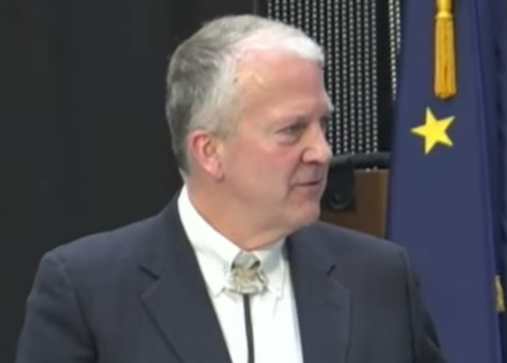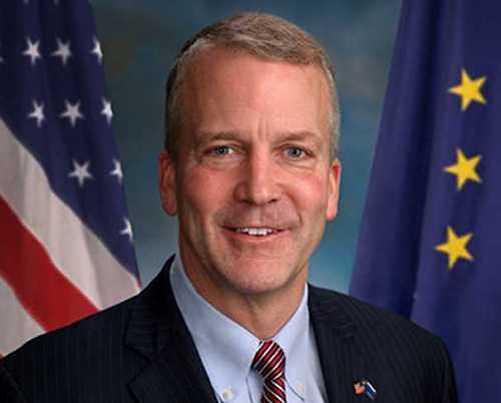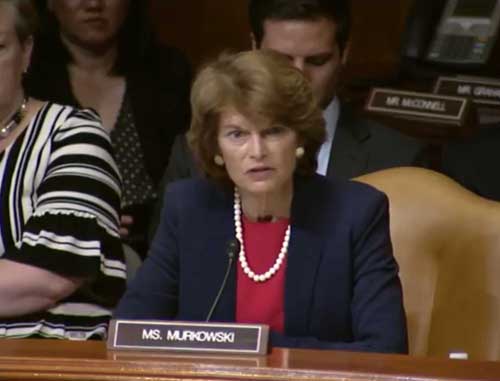[dropcap]W[/dropcap]ASHINGTON, D.C. – U.S. Senator Lisa Murkowski (R-AK) last night voted in favor of S. 140, The Coast Guard Authorization Act of 2018, which passed in a 94-6 vote. The bipartisan legislation co-authored by Senator Dan Sullivan (R-AK), co-sponsored by Senator Murkowski, will further develop America’s presence in the Arctic, support the maintenance and repair of U.S. Coast Guard infrastructure, and improve safety among recreational boaters. The reauthorization also provides Alaskan fishermen permanent exemption of vessel discharge permitting requirements for commercial fishing vessels.
“I thank Senator Sullivan for his leadership and hard work on this bill as Chairman of the Commerce, Science, and Transportation Committee’s Subcommittee on Oceans, Atmosphere and Coast Guard. An investment in the Coast Guard is an investment in the safety of Alaskans, our environment, and our maritime region. This bill is a step towards further developing our presence in the Arctic and will help us engage more deeply in activities in the North, providing an opportunity for increased development in the region,” said Senator Murkowski. “I’m particularly pleased that this bill will permanently exempt Alaskans from the EPA incidental discharge regulation, providing much needed protection for our fisherman and coastal communities. In the past, Alaskan fishermen and more than 8,000 boats statewide have been at risk of serious fines for simply rinsing fish guts off their deck, or rainwater washing other materials off their decks. This finally resolves this issue.”
[content id=”79272″]
Alaska Highlights:
- Strategy in the Arctic: Supports continued growth of the Arctic in national security interests and economic prosperity. Requests a report that provides a status update on implementing its Arctic Strategy, including an analysis of the sufficiency of the distribution of National Security Cutters, Offshore Patrol Cutters, and Fast Response Cutters both stationed in Alaska and in other locations to meet the strategic objectives of the Coast Guard’s Arctic Strategy.
- Arctic Communication and Emergency Response: Requests a plan to provide ship-to-shore communications throughout the Coastal Western Alaska Captain of the Port Zone; the feasibility of establishing a vessel traffic service in the region; and an assessment of the need for an Arctic Response Center of Expertise and ability to respond to emergencies (including response time) throughout the region.
- Arctic Operations: Directs the Coast Guard to conduct a review of the assets and personnel required to ensure the safety and security of the Arctic.
- Arctic Planning Criteria: Calls on the Coast Guard to verify and test equipment listed in any oil spill response plan that provides coverage in the Arctic prior to approval of the plan and then again, every three years.
- Oil Spill Response Capabilities: Requires report language on the level and location of spill response assets in the Arctic and a determination if the equipment cache locations are adequate for rapid deployment and requires the Coast Guard to update the committee on its ability to conduct port assessment visits and what resources are needed to conduct port assessments, exercises, response plan review, and spill responses.
- Multiyear Contracting: Authorizes the Coast Guard Commandant to utilize several new acquisition tools, including multiyear funding for procuring future National Security Cutters. These changes will allow the Coast Guard to reduce the price of follow-on vessels and give shipyards greater predictability, stabilizing workforces.
- Deputy U.S. Marshals: Authorizes commissioned officers to be appointed as Deputy U.S. Marshals in Alaska.
- Land Exchange: Enables limited development in Women’s Bay, while still protecting future Coast Guard operations and adding valuable conservation land to the federal land holdings. This provision will enable the transfer of the privately owned Ayakulik Island, containing an environmentally sensitive rookery, to the Secretary of Interior to benefit the mission of the Fish and Wildlife Service in exchange for the submerged lands in Women’s Bay.
- Vessel Incidental Discharge Act: Delegates the lead role in establishing standards for discharges incidental to the normal operation of a vessel to the Environmental Protection Agency (EPA) and assigns the Coast Guard the lead role in monitoring and enforcing standards. Accommodates unique regional situations, such as Alaska. Allows states to establish no-discharge zones for areas that require additional protection.
National Highlights:
- Ballast Water: Creates a framework for national ballast water discharge rules to address environmental concerns about the spread of invasive species and provides a more robust role for state consultation in the setting of the Environmental Protection Agency’s standards.
- Maritime Border Enforcement and Drug Regulation: Helps control and combat illegal transportation by national and transnational criminal organizations by bolstering the budget for investigations and increasing interagency cooperation.
- Polar Star: Authorizes the rolling recapitalization of the POLAR STAR for 7-10 years in order to provide for maintenance necessary to extend the service life of the icebreaker until at least December 31, 2025.
- Small Shipyard Contracts: Requires that the assignment of Coast Guard vessel conversion, alteration, and repair projects be based on “economic and military considerations” and not be restricted to a particular type of shipyard or geographical area. The provision aims to ease the geographical restrictions on Coast Guard shipwork assignment, which could be particularly beneficial for those Coast Guard vessels homeported in Alaska that are required to transit hundreds of miles south for maintenance and repairs.
- Commercial Fishing Vessel Safety National Communications Plan: Calls on the Coast Guard to develop a strategy for improving communications with the commercial fishing industry.
- Recreational Boating: Improves safety requirements for recreational boating by requiring the installation of engine cut-off switches and alternate signaling devices.








